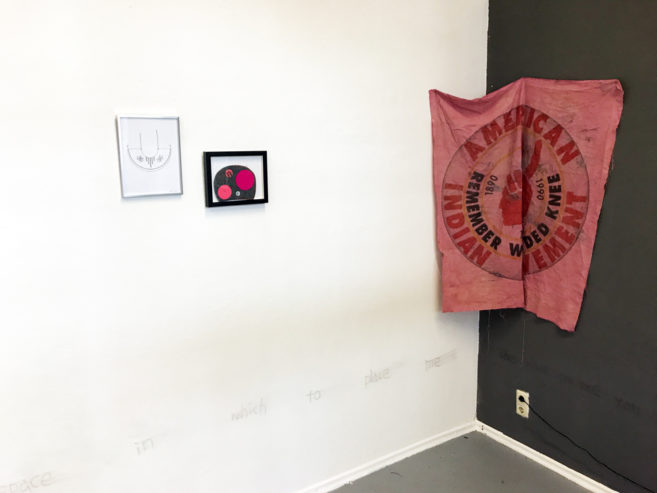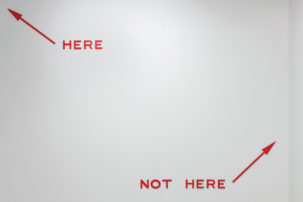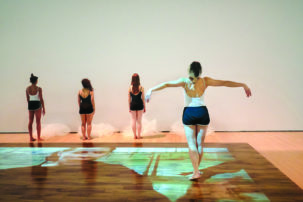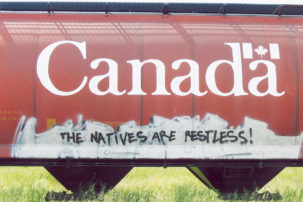How might it be possible to enact tenets of treaty—like mutual accountability, reciprocity, relation across difference and stewardship of resources—in the art world? What does it mean for a settler-colonial art institution to unknow its power? Why should artists and art organizations, whether Indigenous and settler, be cautious of using words like “Indigenize” and “decolonialize” to describe their work?
These are just some of the questions being explored right now in an in-depth, year-long project in Montreal. In many ways, the project is a case study in working through a temporary Indigenous reimagining of an institution—and it’s unfolding publicly, in real time.
For all of 2017, the non-profit public art space SBC Gallery is being renamed as—and is operating as—the Wood Land School. This school is a travelling project first instigated by Omaskêko Cree artist Duane Linklater, and here being organized by him with Alutiiq artist Tanya Lukin Linklater, curator cheyanne turions (who identifies as being of Indigenous and settler descent) and Kahnawake-born artist Walter Scott.
“Wood Land School: Kahatènhston tsi na’tetiátere ne Iotohrkó:wa tánon Iotohrha / Drawing a Line from January to December” is conceived as a single year-long exhibition that will unfold through a series of gestures—clusters of activity that bring works into and out of the gallery space—such that the exhibition is in a constant state of becoming.
Manifesting these gestures—which range from the year-long display of a single Annie Pootoogook artwork to hosting a talk by Brian Jungen about his lesser-known drawing practice, to providing a platform for a poetry reading by Layli Long Soldier—requires frequent conversations and negotiations with SBC Gallery staff such as curator Pip Day and exhibitions and communications manager Julia Smith. So does establishing the ongoing groundwork for the project, from email signatures to website content to workspace to salaries.
The following conversation between John Hampton and two members of Wood Land School—Duane Linklater and Tanya Lukin Linklater—was conducted a month before the project opened to the public, while the artists were working through their intentions, expectations and struggles with undertaking such an endeavour. John is a curator and artist himself, and is invested in unpacking the complexities of contemporary Indigenous art and identity (and its intersection with institutional contexts) through dialogue and curatorial practice. Together, John and the Wood Land School touch upon relationship, slowness, ceremony, identity, unpaid labour and many other issues relevant to artists and curators undertaking this kind of work.
And just as “Drawing a Line” extends for a year, Canadian Art intends for this series to unfold over a year as well. Watch for future conversations in coming months between John and other Wood Land School members. This series of discussions is, of course, but a part of one larger, ongoing conversation between the participants and a wider community of Indigenous artists, writers, curators and thinkers across Canada and the globe.—Leah Sandals, managing editor, online
John Hampton: Can you talk a bit about how this project began?
Duane Linklater: When we decided to do this year-long project, and started thinking about how we wanted to do it, we brought forth conditions about what we would require—money, labour and space—to function. Those things were negotiated between SBC and the Wood Land School.
Tanya Lukin Linklater: And in our thinking around labour, we wanted to acknowledge that relationships run into labour too. We have relationships with one another, and we are also building a relationship with SBC Gallery. We wanted to give the unfolding of these relationships and ideas room, to have a slow exhibition—
Duane: A slow exhibition—a year-long duration of different artists moving slowly in and out of the exhibition as it unfolds.
The first gesture centres around a work of Annie Pootoogook that has been loaned to us by a private collector for one year. This single work, Coleman Stove with Robin Hood Flour and Tenderflake, will be on view for the entire project.
John: Whose collection is the Pootoogook work from?
Duane: Reid Shier. He’s the director of Presentation House Gallery in Vancouver. This notion of lending and borrowing is interesting to us—
John: And Annie Pootoogook had a complicated relationship with the art market—
Duane: Definitely, but we wanted to avoid certain tensions of those complications, and focus on giving the space that her work requires in this exhibition across the year. The year began with a reading of a text about Annie by Heather Igloliorte–she wrote an obituary, a beautiful text, for her.
Tanya: That is the first reading that will take place, in both English and Inuktitut, and the text may also stay in the gallery over the duration of the year as well.
John: I’m interested in how you navigate between someone’s public presence, like Annie’s, which has had such a major impact on the Canadian Indigenous art communities, and the responsibilities required in respect to her family or personal connections.
Tanya: I think that is a really important ethical question, and I think conversations like that are why we want this work up for the entire year, so that over the course of that time we can examine those relationships. Although we may not go into those personal relationships, we are giving space to the work and to her memory.
This work is so central to the entire project—it’s a way of honouring her and her legacy—but there are also certainly a lot of important ethical questions that we are really trying to think through. Maybe it is important to address our concern for the family, for their grief and for the situation.
Duane: In my own work, I particularly like to acknowledge the work of Indigenous artists who have passed on. There is something really important about that relationship—specifically between art and artists—that becomes important and signals a responsibility that we have to each other.
We all know there are sensitivities about representing someone who has passed on—cultural sensitivities—depending on where you are coming from, and what you have learned. And we want to respect that. But we also think that it is important to acknowledge the differences between ceremony and art. I’m very careful about bringing one into the other, because, for myself, when it occurs, it is dangerous.
Speaking as a person who is not an authority on ceremony, but speaking as a person who goes to ceremonies and listens to elders, and has learned that way—but is not an authority—I believe the distinctions between art and ceremony are important.
And so I think it is important that we are a group of Indigenous people—artists, curators and thinkers—that want to take this on, to take it on in a way that non-Indigenous people can’t, but, at the same time, not to conflate this with ceremony or traditional practices.
For us, it’s an articulation of us taking care of each other as artists and artwork. I’m not sure if that can be done by non-Indigenous people—or I’m not sure I want it to be done by someone who isn’t Indigenous. That relationship of Indigenous artists is important; either when we are here together, or when we are thinking of ones who have passed on.
John: What you’ve described to me, about your desire to let the exhibition unfold, rather than plotting a predetermined outcome, seems in line with a certain type of curatorial methodology that is more collaborative, which thinks of an exhibitions as a coproduction between artists, curators, institutions and audiences.
But while that is a familiar way of working for me, the relationship you are developing with SBC is radically different from what I’m used to. What is happening is sort of like an elevated open studio, or an extension of the model of an exhibition-as-laboratory.
And in pushing this stance, I’m curious what happens to the institution that is temporarily giving up its identity. In your contract—or, as described in Wood Land School language, the treaty—between you and SBC, have you replaced the administration? Joined them? Are you just compressing one year’s worth of artist fees, or are you staff?
Duane: No, we’re not staff, but that is still unfolding. Some of the language is very difficult to decide upon. We had conversations around words that we didn’t want to bring into this project, like occupation—“Wood Land School occupies SBC for one year,” for example. That kind of context suggests so much that we, as a group, were collectively not interested in.
John: Instead, you sometimes describe SBC as hosts, a term that has very different historical connotations.
Duane: Exactly. The language, up to this point, has been a struggle—to find language that describes what we are doing. To me, that signifies that there is a failure of language to encapsulate what we are doing.
Tanya: In our relationship with SBC, we have decision-making control, and we are really listening to one another in terms of practical things. SBC has been very open to what we are doing and to the level of control they have given us, but they have a very important role in terms of labour. So we had a lot of conversations about the website, and what it would look like, and how Wood Land School could take space on www.sbcgallery.ca, and we ended up taking that entire space.
Duane: I’ve been thinking a lot about what is at stake for white artists, in relation to what is at stake for Indigenous artists or what is at stake for Black artists.
There are many artists who are pushing a kind of levity when approaching the institution—but with a predominately white group of artists, what are the stakes of that? For us, the stakes are very different, as a group of Indigenous people, artists and curators.
John: And that connects to that struggle with language. When we work outside of established categories, you need to renegotiate all of the terms of these social (and written) contracts that exist within art ecosystems.
This is a problem very familiar to people trying to Indigenize governance models—a board can unanimously agree to move away from Robert’s Rules, but then still keep on falling back into it, because it takes so much time and thought to have to reinvent every subtle agreement that you take for granted, and it is so much easier to fall back upon habit when you all already speak a common language of governance.
Duane: Totally. A quick example: we had to put a lot of thought into email signatures. Something that you take for granted now becomes this space that has to be rethought.
Tanya: I can’t speak for Pip Day, SBC’s director/curator, but I’m sure she’s wondering how her role has changed. How does she speak about Wood Land School to other people? I wonder if the fact that Duane, Walter and I are not curators gives us an advantage?
We are approaching this project without a default mode of operating that we can fall back on—but that’s not to say that the other people we are working with, cheyanne or Pip, are not partially guiding us in that way. We’ve had lengthy conversations about all of these pieces, because they all mean something. This all makes the endeavour a lot of labour. I think that is much harder than coming in as a writer, a curator or an artist, who is used to working within a pre-existing structure.
John: I’m wondering how the approach you are taking plays into, or against, critiques that increasing Indigenous presence in exhibitions is just a superficial shortcut—that it renovates the facade while leaving structural frameworks in place…
I was going to ask whether your project could be read as an extension of this practice (just with a longer timeframe), or if it will have any long-term impact on the structure of the organization, but now I’m very interested in this other experiment that you are undertaking in reconsidering the less-visible structures of the institution. So many institutions are currently trying to “Indigenize” to varying degrees, but I’m not sure if they appreciate the monumental scale of such a task. To undertake this relatively small-scale, temporary transformation, at a nimble artist-run centre like SBC, you still have thousands of invisible standards that have to be renegotiated.
So I’m wondering about how you then scale this effort to larger and larger (and slower-moving) institutions until you get to something as large as Canada itself. Looking at it that way, what you are undertaking right now could function as a sort of case study on Indigenous reimaginings of institutions. In a way you are acting as a think-tank—a radical experimental consultancy firm that is looking at how to rebuild the structure of artist-run centres, which have a 40-year history but rely on of a much longer history of structures underneath.
Duane: It’s important to think about how the redoing is happening, though. There is something important about not knowing until we do it.
Tanya: There is something to be said about it not being a government, health or educational structure, where the stakes are so high in terms of failure. As artists, we are a lot more open to the prospect of failure; failure is something that can happen in this project.
John: That’s a nice way of considering the value we place on failure in the art world.
Duane: In an artist’s thinking, failure holds potential. To think about what failure produces and to think about what success produces—I’m unsure about the comparison of those productions. Both of them are important.
John: And it’s worth stating that even if the stakes of your experiment are lower than other institutions, they are still higher than some more light-hearted forms of institutional critique. What you are doing has a parallel to decolonization or Indigenization efforts, and as artists who are choosing to rethink an institution through an Indigenous lens, you are taking on an ethical responsibility; what is done here, in Wood Land School, will likely influence your audience’s understanding of parallel efforts that are being attempted at other institutions in a less abstract manner.
By taking up these issues, there is a higher degree of scrutiny around ethical concerns, like labour and compensation. How you are being compensated in this project also has conceptual and ethical ramifications connected to larger issues of compensation—not just for artistic labour but also for the labour expected of BIPOC people.
I’m thinking particularly of the role non-white cultural actors often take on as unpaid cultural consultants. SBC has been renamed Wood Land School, and you have taken on these administrative duties. I’m assuming that SBC staff are staying on in their current roles at their current wages, but you are undertaking many of the duties that would typically be considered their jobs.
So I’m curious how you, as cultural workers, consultants and artists, are being compensated. It means something very different if you receive a salary for this year than if you are just working with the entire year’s programming budget, from which you would negotiate an artist fee.
Tanya: Well, we do have the entire year’s programming budget, and we’ve applied for and received an Andy Warhol Foundation grant. But the SBC programming budget is typically raised through fundraising, and there is a separation from the gallery’s core operating funding, which ensures the stability of the organization.
We haven’t had a discussion about salaries, because the staff is still there operating in a significant way. Pip is managing the fundraising, and we help with the grants that are put together, but they undertake most of the labour and responsibility for those administrative duties.
Duane: They have agreed not to make creative decisions about exhibitions without us.
Tanya: SBC has developed relationships that are essential to the project, that help navigate some of the things that we wouldn’t be aware of. I’m an administrator at a university, so I know what that’s like—my work there happens all day every day, whether or not I’m the face of a project. So it’s not something to take lightly.
I think that part of the issue is that artists and curators, as a whole, are not typically making a living wage; with the exception of people working within a different type of institution, like those who have chosen to be academics. It’s rare. For independent artists and independent curators, it’s very difficult. So I think this has to be considered in a larger understanding of working conditions in the arts landscape.
Duane: I think that speaking of invisible labour is important. We are undertaking more labour than our roles would suggest. And this is something that has been on my mind from the very beginning, and I think that at some point, it needs to be more directly discussed.
It’s important to think of these structural and administrative things, and also think about the content—the “actual” art. How do these two things move each other? As we move along throughout the year, what kind of conversations do we start to think of as meaningful?
Tanya: The context in Canada right now, and internationally, creates different points of reference as well: in terms of Standing Rock, Colten Boushie, Annie Pootoogook and what’s happening nationally with Indigenization, which is certainly a push across the country and on the ground in different ways. Within the limits of Indigenization, and the limits of reconciliation, how does this work happen within this broader context?
I think sometimes people don’t have clear and concise definitions of what they mean by decolonization, or Indigenization, or any of those terms that are being used quite a bit right now. There has to be more thinking through of what these words and actions mean, because they will present themselves in different ways in different locations. They will not always happen in the same way, and we can’t just take one model and apply it across the world.
And I guess that is part of what we are thinking through within this experiment. Not that we are using the language of decolonization or Indigenization—to be clear, we are not—instead, we are trying to find language, and find a way through this. What does it mean for us to come into this space and effect a kind of change? I don’t know. But we wanted to allow ourselves space to think through the exhibition, to let it unfold, for us to have conversations to inform the work, because that’s how we want to work.
John G. Hampton is a curator and artist currently living in Treaty 2 territory, Manitoba. He is the executive director of the Art Gallery of Southwestern Manitoba, adjunct curator at the Art Museum at the University of Toronto, and sits on the board of directors for the Aboriginal Curatorial Collective. He was born in Boston of Chickasaw and European ancestry in 1985.

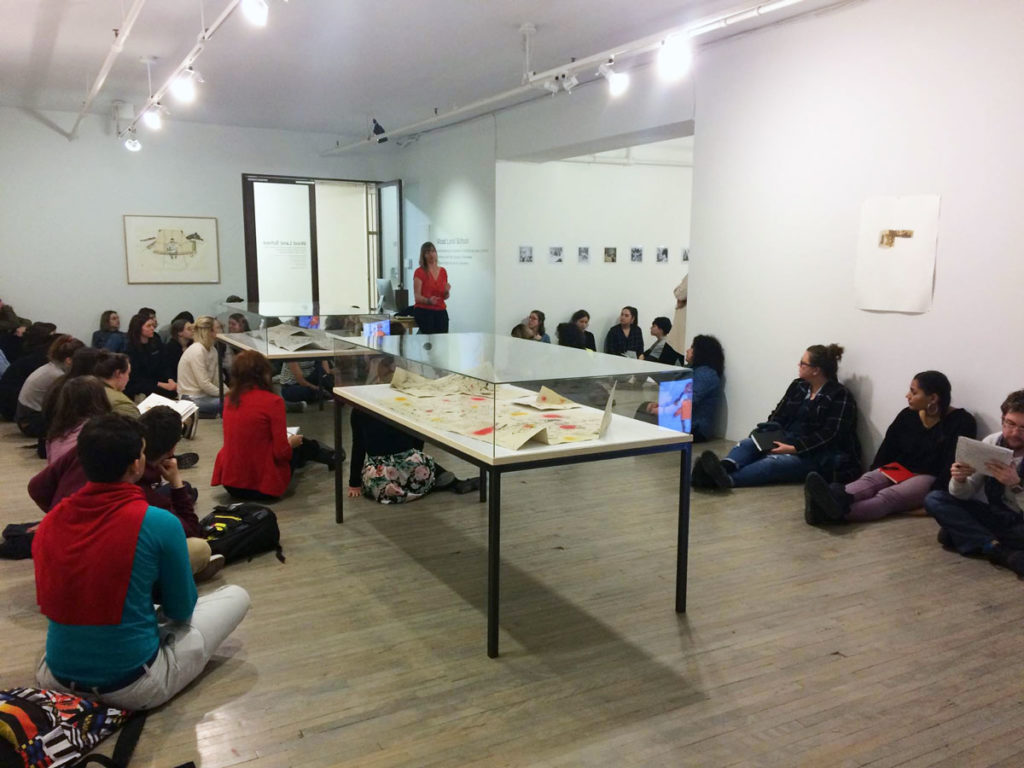 UQAM students taking a course the history of art and museology discuss Wood Land School: Kahatènhston tsi na'tetiátere ne Iotohrkó: wa tánon Iotohrha / Drawing a Line from January to December in relation to their class on “new institutionalisms.” Photo: Via SBC Gallery Facebook Page.
UQAM students taking a course the history of art and museology discuss Wood Land School: Kahatènhston tsi na'tetiátere ne Iotohrkó: wa tánon Iotohrha / Drawing a Line from January to December in relation to their class on “new institutionalisms.” Photo: Via SBC Gallery Facebook Page.
